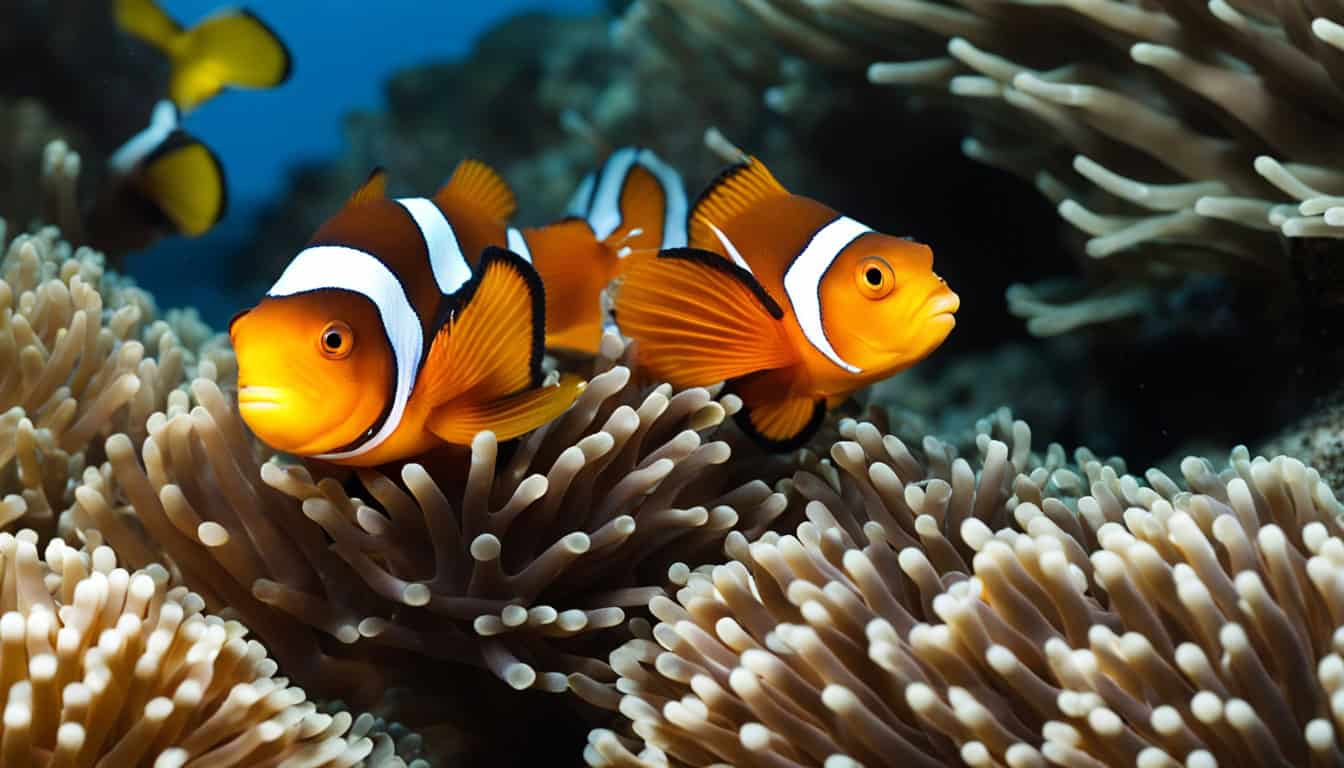Clownfish are known for their bright colors and interesting behaviors. You might be curious about how they take care of their eggs. This article will explain how clownfish care for their eggs and their unique reproductive habits. It will cover the key steps to create a good breeding environment and understand the incubation process for the eggs to survive.
Understanding Clownfish Reproductive Habits
Clownfish have interesting ways of reproducing. They can switch from male to female, which helps them in finding mates. This flexibility is key in both the wild and in captivity.
For them to spawn, they need the right lighting and water conditions. A good diet also keeps them healthy, which is important for breeding. Before they reproduce, they clean a flat area, like a rock or tile. This shows their breeding behavior and prepares a safe spot for laying eggs.
Clownfish work hard to make sure their eggs have the best chance to survive. Their breeding habits show how dedicated they are to their species’ future.
How do clownfish care for their eggs?
Understanding how clownfish care for their eggs is key to successful breeding. Clownfish are known for their bright colors and unique ways of taking care of their eggs. This part will look into the characteristics of clownfish eggs and their growth during this time.
Initial Egg Characteristics
Clownfish lay their eggs as bright orange clusters, usually between 100 to 1,000. These eggs are vital for the species’ survival. To care for them, it’s important to create the right environment. Keeping an eye on the temperature is crucial as it affects the eggs’ health and survival.
Developmental Stages of Clownfish Eggs
The development of clownfish eggs takes several days. At first, they are bright orange but turn more see-through as they grow. In the best conditions, it takes about 6 to 8 days for them to hatch. About 24 hours before hatching, the eggs look silver, showing that the larvae are ready.
This is the best time to get ready for hatch day. Knowing when the eggs will hatch is important. The eggs usually hatch a few hours after it gets dark in their natural setting.
Keeping track of the developmental stages of clownfish eggs helps you care for them better. This knowledge improves your breeding skills and helps the larvae thrive once they hatch.
| Development Stage | Visual Characteristics | Duration |
|---|---|---|
| Initial Stage | Bright orange clusters | 0 days |
| Translucent Stage | Eggs begin to lose their color | 3-6 days |
| Pre-Hatching Stage | Silver appearance | 24 hours before hatching |
| Hatching | Free-swimming larvae emerge | 6-8 days |
Choosing the Right Breeding Environment
Creating the best breeding space for clownfish is key to successful egg care. A well-thought-out breeding tank boosts healthy egg growth and lowers stress for the fish. Here are important tips for setting up a tank that meets your clownfish’s needs.
Setting Up the Breeding Tank
A 20-30 gallon tank is perfect for a pair of clownfish. Use a sponge filter for good filtration without strong currents that could harm the eggs. Keeping the tank clean and disinfecting it often is crucial for a safe breeding spot. A lighting system that mimics daylight can also encourage clownfish to spawn.
Water Quality and Conditions
Excellent water quality is crucial for clownfish eggs. Aim for a temperature of 77°F to 79°F, pH 8.1 to 8.4, and salinity of 1.020 to 1.026. Regular checks of these levels ensure a stable home for the fish and their eggs. Changing the water often is key to keeping the tank ready for spawning and egg growth.

Clownfish Egg Protection Strategies
In the world of clownfish parenting, protecting their eggs is key for successful hatching and the fry’s health. They use many strategies to keep their eggs safe. These include both the parents’ behavior and making a safe environment for the eggs.
Behavioral Protection by Parents
The parents are crucial in protecting the eggs. The female guards the nest and scares away predators. The male keeps the eggs clean by fanning water over them. This keeps the eggs healthy and ready to hatch.
This active parenting helps more eggs survive. It shows how important the parents are to their eggs.
Environmental Shielding for Eggs
Protecting the eggs also means making a safe environment. In a community tank, using clear covers helps keep the eggs safe. Putting the eggs on stable rocks or tiles also helps avoid tank mate disturbances.
These steps help increase the chances of successful clownfish egg care. They show how important a safe place is for the eggs to grow. It highlights the instincts of clownfish and the need for a secure environment for their young.
FAQ
How do clownfish care for their eggs?
Clownfish show strong parenting. The female guards the eggs. The male keeps the area clean by fanning water over them. This protects them from debris and predators.
What are the initial characteristics of clownfish eggs?
Clownfish eggs start bright orange and are laid in clusters of 100 to 1,000. As they mature, they turn more translucent.
How long does it take for clownfish eggs to hatch?
Clownfish eggs hatch in about 6 to 8 days. This depends on the water temperature and other factors.
What is the optimal tank setup for breeding clownfish?
For breeding clownfish, a 20-30 gallon tank with a sponge filter is best. It should have stable, clean conditions.
What are the ideal water conditions for clownfish egg care?
Keep the water temperature between 77°F to 79°F. The pH should be between 8.1 to 8.4. Salinity should be around 1.020 to 1.026 for the eggs.
How do clownfish protect their eggs?
The female guards the eggs. The male fights off threats. They both provide oxygen and keep the area clean.
How can I enhance the survival chances of clownfish eggs?
Use barriers to protect the eggs from disturbances. Place them on stable surfaces. This helps with survival and fry development.
What are common issues to watch for during clownfish egg incubation?
Keep an eye on water quality, temperature, and other factors. This helps prevent problems that could affect the eggs and hatching rates.







